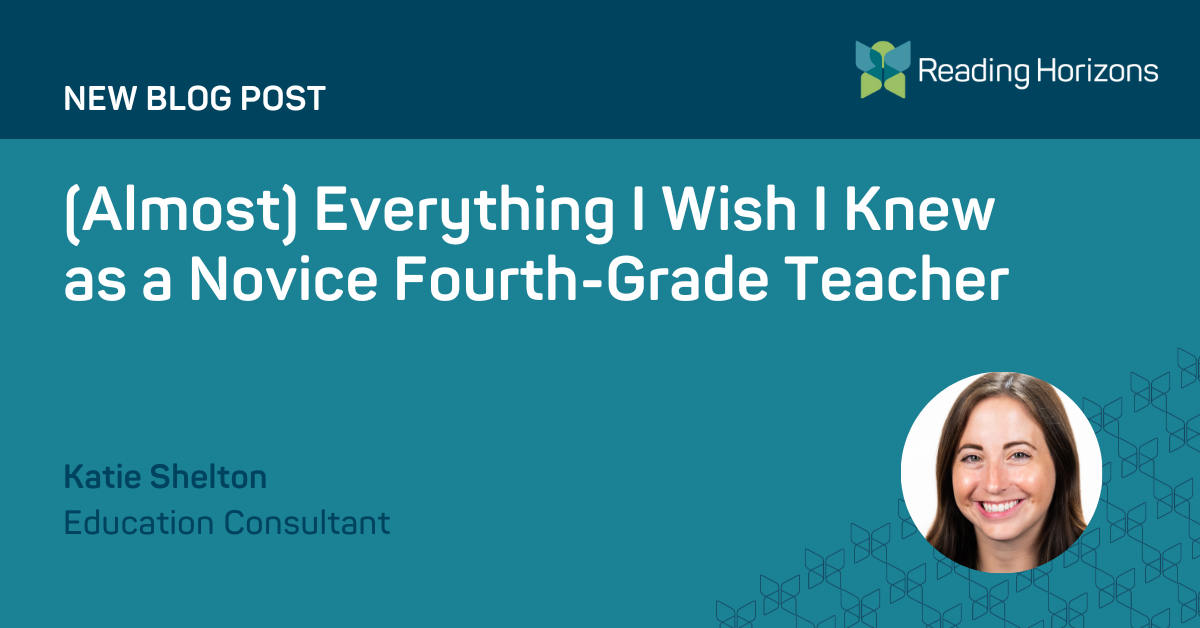
BY KATIE SHELTON, EDUCATION CONSULTANT
Recently, Reading Horizons released a new ebook, Four Literacy Myths of Older Learners, which made me reflect on my six years as a fourth-grade teacher.
When I first stepped into the classroom, I deliberately chose to teach the older grades. I was eager to delve into complex texts and discussions, believing that my students already had a solid foundation in reading. However, my benchmark testing scores revealed a different reality year after year.
Clearly, I couldn’t ignore the need to teach foundational reading skills.
When almost half of my students were below the 50th percentile in their reading abilities, I knew I needed to adjust my teaching to fit their learning needs.
Now, as an Education Consultant, I work with teachers nationwide who face similar struggles. Middle and high school teachers ask me, “What can I do when students are more than two grade levels behind? They can’t read the text I give them.”
Knowing how unprepared I was as an elementary school teacher, I can’t imagine how overwhelmed I would feel as a middle or high school teacher trying to tackle foundational reading skills. As I do in my consulting work, here I’ll share tips to take back to your classroom, so you feel prepared to help your older students learn to read proficiently.
Assess and Address
Comprehension is significantly affected when students lack foundational skills. Therefore, educators should prioritize assessing and addressing foundational reading skills before improving comprehension.
If my students struggled to decode a text, I always said in intervention meetings, “Just let me read the text to them! If I read the text aloud, they’ll be able to comprehend it!” Here’s what I was missing: The Simple View of Reading (Gough and Tunmer, 1986) clarifies that reading comprehension cannot occur without strong decoding and language comprehension abilities.
The students I was helping had strong language comprehension skills. However, when asked to read a passage independently, they couldn’t accurately decode to comprehend the text. Therefore, the intervention should not have included a read-aloud accommodation; the issue was decoding, and I needed to focus on explicit foundational literacy instruction.
Once I realized decoding was the key, I turned to Google for guidance.
If you’ve ever found yourself searching, How do I teach a student to read?, know you’re not alone.
Incredible resources, from podcasts to online educator communities, provide valuable insights. Remember, we are all lifelong learners!
Constantly Build Confidence
Providing students with dependable patterns can enhance motivation, engagement, and confidence in reading.
As an educator, I’ll never forget the first time I learned the C/K Spelling Rule. For years, my students asked, “Why is kitten spelled with a k but cat is spelled with a c?” My answer was always, “I don’t know. The English language is weird!” Unknowingly, I was making learning to read seem more difficult than it needed to be.After 10 years of teaching, I finally learned the C/K Spelling Rule for the /k/ sound!

Talk about a lightbulb moment! Even as an adult, I didn’t know this dependable spelling pattern existed. Once we understand the language patterns, we can better equip our students with this knowledge.
I recently visited a middle school to speak with reading teachers. During our meeting, a student walked in, and the teacher asked, “What is your favorite thing about Elevate?” (Reading Horizons Elevate® is Reading Horizons’ solution for grades 4 and up).
This eighth grader thought for a moment and then replied, “I like breaking down the words; it makes sense.”
When we empower students with English language patterns, we give them the missing piece of the puzzle! It’s enlightening for students to demystify the reading process. They feel like they’ve broken a code or solved a riddle.
One of the most important things we can do for learners is reduce the perceived difficulty of learning to read. Confidence leads to success!
Provide Proper Texts
Have you ever sat down to read a research-heavy, jargon-filled book and quickly realized you were in over your head? Students can feel the same way when they try to read text with words they can’t decode!
If you insist that fourth graders need to practice on fourth-grade texts, your students are likely to quickly lose confidence and motivation. Instead, provide accessible texts that enable simultaneous practice of foundational skills and engagement with grade-level skills.
When I placed a challenging text in front of a striving student, I could see the frustration start to build. The student would just stare at the text while others were reading. When it came time to answer questions, the student would respond with “I don’t know” for every answer.
However, once I lowered the text’s complexity, my students were able to access the content.
Here’s how it works:
- Use a lower Lexile® passage and highlight the challenge words to practice in advance. These challenge words often turn into an excellent vocabulary lesson!
- Read the text multiple times—through choral reading, teacher modeling of a fluent read, and partner reading—so students can focus on the meaning within the text rather than spending all their mental energy on decoding.
- Focus on strategy instruction with appropriate texts, such as generating and asking questions, summarizing the text, and having students write about what they read.
Instead of allowing frustration to build, my students learned to analyze the text and find the answers to the comprehension questions. Using this process as a starting point, students can work their way into more complex texts, supported by explicit foundational literacy instruction.
Don’t Give Up!
What you learn in school is just a start. In the classroom, I quickly realized that a “by the book” approach only worked for a handful of students—not all.
Implementing a foundational reading intervention tailored to older learners can significantly impact their literacy outcomes and future success. Let’s continue to challenge assumptions and innovate in our teaching practices, ensuring every student has the opportunity to become a confident and skilled reader.
When our students become stronger readers, we open up a world of opportunity for them.
For more on this topic, watch this free, on-demand webinar: Myth Busting! 4 Misconceptions About Literacy Learning in Upper Grades.

